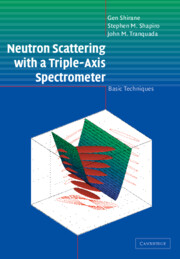Book contents
- Frontmatter
- Contents
- Preface
- 1 Introduction
- 2 Scattering formulas
- 3 Elements of a three-axis instrument
- 4 Inelastic scattering and the resolution function
- 5 Phonons and magnons
- 6 Spurious peaks
- 7 Bragg diffraction
- 8 Polarized neutrons
- Appendix 1 Neutron scattering lengths and cross sections
- Appendix 2 Crystallographic data
- Appendix 3 Other useful tables
- Appendix 4 The resolution function for a triple-axis neutron spectrometer
- Index
3 - Elements of a three-axis instrument
Published online by Cambridge University Press: 19 August 2009
- Frontmatter
- Contents
- Preface
- 1 Introduction
- 2 Scattering formulas
- 3 Elements of a three-axis instrument
- 4 Inelastic scattering and the resolution function
- 5 Phonons and magnons
- 6 Spurious peaks
- 7 Bragg diffraction
- 8 Polarized neutrons
- Appendix 1 Neutron scattering lengths and cross sections
- Appendix 2 Crystallographic data
- Appendix 3 Other useful tables
- Appendix 4 The resolution function for a triple-axis neutron spectrometer
- Index
Summary
The three axes involved in a triple-axis instrument are the monochromator axis, the sample axis and the analyzer axis as shown schematically in Fig. 3.1. However, there are many other elements of a three-axis instrument which are necessary in order to have an efficient spectrometer. These include monochromator and analyzer crystals, energy filters, collimators, and detectors. Since each axis and crystal has to be individually moved for every setting of the instrument, computer control is essential. In addition, extensive shielding is required in order to protect the experimenter and to reduce the overall background or noise in the experiment. In this chapter we shall discuss each of these elements in some detail.
Shielding
Most modern reactors have beam tubes which do not look directly at the core, but instead have their axes tangential to it. This decreases the quantity of unwanted high-energy (≳ 200 meV) neutrons (also called fast neutrons) in the beam tube, since only those neutrons that have a component of velocity nearly parallel to the beam-tube axis can enter the monochromator area. Neutrons which satisfy this condition have necessarily undergone collisions with the moderating material and have lost considerable energy compared to fission energies. The moderation is never perfect, and there are always some fast neutrons that enter the monochromator area, along with γ-rays and other unwanted radiation. It is therefore necessary to shield adequately against this unwanted radiation. The shielding should contain a combination of materials that can scatter the fast neutrons, slow them down, and then absorb them. In addition, a significant amount of lead is needed to absorb the dangerous γ-rays.
Information
- Type
- Chapter
- Information
- Neutron Scattering with a Triple-Axis SpectrometerBasic Techniques, pp. 55 - 93Publisher: Cambridge University PressPrint publication year: 2002
